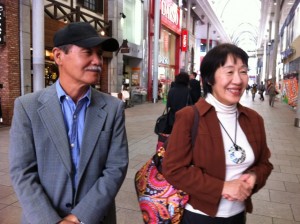WIT Life #140: Hibakusha Stories
WITLife is a periodic series written by professional Writer/Interpreter/Translator Stacy Smith (Kumamoto-ken CIR, 2000-03). She starts her day by watching Fujisankei’s newscast in Japanese, and here she shares some of the interesting tidbits and trends together with her own observations.
This week I had the unique opportunity to work as a volunteer interpreter for a project called Hibakusha Stories. Hibakusha (被爆者) is the official designation for atomic bomb victims, and this is the second time this organization has invited them to come to America to tell about their experiences. The program involves visits to NYC high schools, where groups of students gather to hear what these amazing survivors have to say. I had the honor of working with a beautiful woman from Hiroshima, 72-year old Toshiko Tanaka , who was generous enough to share her story.
, who was generous enough to share her story.
Toshiko was almost 7 when the bomb was dropped and managed to make her way home. Her own mother didn’t recognize her, and she was in a coma for a week but somehow miraculously survived. Besides burns throughout her body, she experienced fainting spells and other effects as a teenager and her vision is impaired. Yet her spirit is indomitable, and she insists on being positive despite what she has been through. She lives in Hiroshima and is active as an artist who uses media like enamel, and many of her works have messages regarding what happened on August 6, 1945 as well as about the peace she is hoping to promote.
 She began speaking about her experience only a year and a half ago, and this was also the first time she told her son about it. She felt hypocritical sharing her story with strangers around the world and not her own flesh and blood. He has a bone deformity in his chest as an aftereffect from radiation, and was made fun as a child by classmates yet his mother never spoke of what had happened with him. While traveling in South America on Peace Boat, she gathered the courage to tell him the truth via a letter. She feared that he would be angry at her, but instead when her ship docked in Tokyo he took her out for sushi and they had a long heart to heart about previously unspoken matters.
She began speaking about her experience only a year and a half ago, and this was also the first time she told her son about it. She felt hypocritical sharing her story with strangers around the world and not her own flesh and blood. He has a bone deformity in his chest as an aftereffect from radiation, and was made fun as a child by classmates yet his mother never spoke of what had happened with him. While traveling in South America on Peace Boat, she gathered the courage to tell him the truth via a letter. She feared that he would be angry at her, but instead when her ship docked in Tokyo he took her out for sushi and they had a long heart to heart about previously unspoken matters.
Toshiko’s message as well as that of all hibakusha is that although this is something that happened 65 years ago, the effects are not just on the immediate victims but later generations as well. 9 nations around the world including our own now hold nuclear weapons, making a total that is estimated to be 23,000. In thinking about the extent of the damage that just one bomb did by killing 140,000 people in Hiroshima (and later 75,000 in Nagasaki) and leaving behind lasting radiation, the terrifying possibilities of our current nuclear situation should be a wake up call. As Toshiko says, “I am not a peace activist or a politician; all I can do is make friends with people around the world. The cycle of hate is broken only with love.” As one person you may wonder what you can do for peace, but loving others is a good start.


Comments are closed.